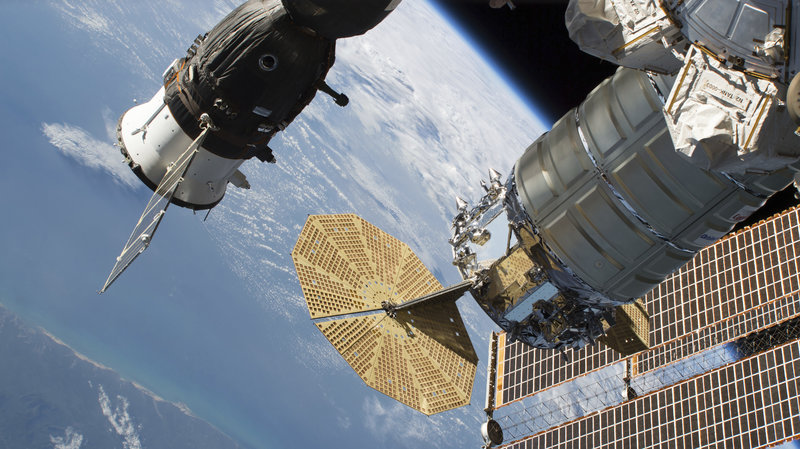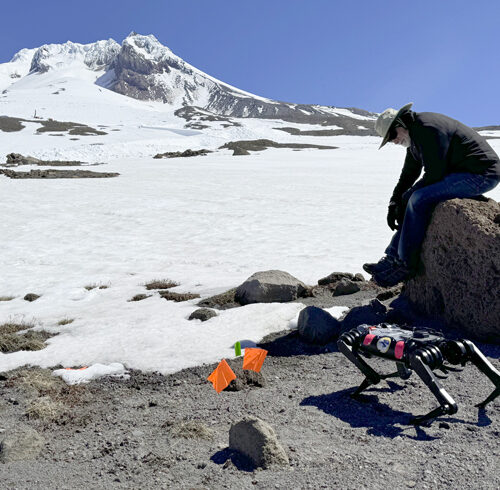
What – Or Who – Caused A Mysterious Leak At The International Space Station?
Listen
BY MERRIT KENNEDY & NELL GREENFIELDBOYCE
Russian officials are saying that a tiny leak at the International Space Station was likely caused by a human hand. Now, they’re trying to figure out who did it, why they did it and whether it happened in space or on the ground.
The crew identified the source of the leak as a 2-millimeter hole in the upper section of a Soyuz MS-09 spacecraft, which is docked in the Russian section of the space station.
“We don’t reject any theories,” said Dmitry Rogozin, the head of Russia’s state space agency Roscosmos, according to state news agency TASS. He added that they’re aiming “to find out whether it was an accidental defect or a deliberate spoilage and where it was done … we will find out, without fail.”
And while Rogozin said they aren’t ruling out the possibility of sabotage, an accident seems more likely: “It seems to be done by a faltering hand… it is a technological error by a specialist.”
Rogozin added that they have dismissed a theory that the hole was caused by a meteorite.
No one aboard the space station was in significant danger as a result of the leak, which was detected last Wednesday evening by flight controllers.
The crew first addressed the problem by applying tape to the hole, according to NASA, and later, Russian flight engineer Sergey Prokopyev plugged the hole using gauze and epoxy, a super-strong sealant.
A Russian cosmonautics expert, Alexander Zheleznyakov, was extremely skeptical of theories that the hole was drilled deliberately from space.
“Why should any of the crew try to do that? I would not like to use the word nonsense, but all this does not fit in well with logic,” Zheleznyakov told TASS.
He offered another possibility: “Most probably all had happened at the manufacturer’s plant. A hole that has been patched up with glue is hard to detect. … Most probably, a worker drilled a wrong hole and then patched it up and then either avoided telling anyone or those he had informed preferred to keep quiet, too.”
The Soyuz spacecraft was made by the Russian corporation Energia, according to TASS. The International Space Station is currently hosting three NASA astronauts, two Russian cosmonauts and one European Space Agency astronaut.
John Logsdon, a space policy expert at George Washington University, told NPR that there is “a kind of generalized concern about the decline of quality control in Russian space industry in recent years.” If the hole was accidental, he said, “and then covered up and nobody inspected and found it … that’s troubling.”
Roscosmos has appointed a commission to investigate and expects its work to be done by mid-September.
Leroy Chiao, former commander of the International Space Station, told NPR that he finds it somewhat mysterious that the hole appears to be hand-drilled through the material that’s about half an inch thick. “It would take a little while to drill all the way through the hole,” he said.
Chiao recalled how the astronauts were vigilant during his expedition about anything that might cause a drop in pressure, like this leak did. “Pressure dips are certainly not a routine thing,” he said.
“So as soon as we hear a noise, we would rush over to the very sensitive pressure gauge to make sure that the pressure was holding,” Chiao said. “That was definitely something that we were attuned to.”
Copyright 2018 National Public Radio
Related Stories:

Astronauta de la NASA José Hernández inspira a estudiantes durante visita a Tri-Cities
EL astronauta de la NASA José Hernández visitó el este de Washington y compartió su historia de resiliencia y determinación con estudiantes locales.

NASA astronaut José Hernández inspires students during visit to Tri-Cities
Surrounded by students seeking autographs and photos, astronaut José Hernández finished one of his conferences at Pasco High School.

How a dog-like robot is training for space exploration on Mount Hood
Dan Koditschek, with the University of Pennsylvania, watches Spirit the robot as it walks from rocks to snow on Mount Hood. (Credit: Courtney Flatt / NWPB) Listen (Runtime 4:20) Read













